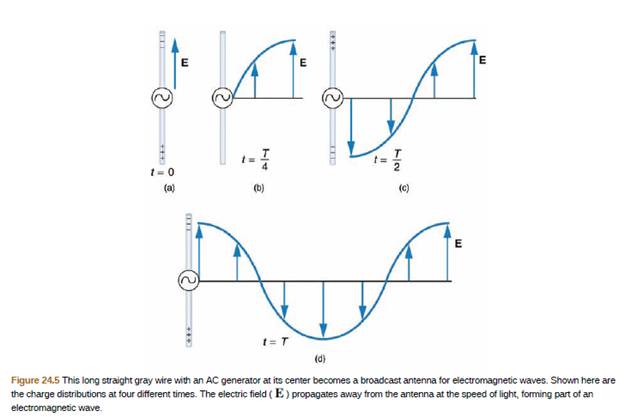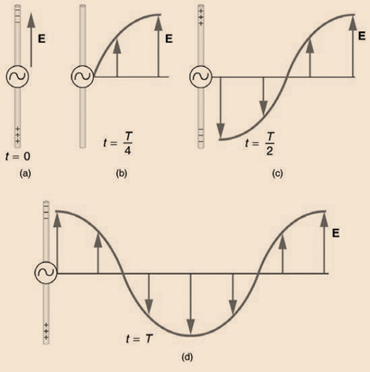
Concept explainers
The direction of the electric field shown in each part of Figure 24.5 is that produced by the charge distribution in the wire. Justify the direction shown in each part, using the Coulomb force law and the definition of E = F/q, where q is a positive test charge.

The direction of the electric field shown in each part of Figure is that produced by the charge distribution in the wire.
Answer to Problem 1CQ
- The direction of the electric field is upward
- The value of electric field is zero.
- The direction of the electric field is downward
- The direction of the electric field is upward
Given info:
Justify the direction shown in each part, using the Coulomb force law and the definition of E=F/q, where q is a positive test charge?

Explanation:
Positive charge moves from positive to negative, so the direction of electric field in part a is towards upper direction.
The distances between the positive and negative charge in part b is zero, so the electric field value is zero, so there is direction.
Positive charge moves from positive to negative, so the direction of electric field in part c is towards downward direction.
Positive charge moves from positive to negative, so the direction of electric field in part a is towards upper direction.
Conclusion:
The direction of the electric field shown in each part of Figure is studied.
Explanation of Solution
Given info:
Justify the direction shown in each part, using the Coulomb force law and the definition of E=F/q, where q is a positive test charge?

Positive charge moves from positive to negative, so the direction of electric field in part a is towards upper direction.
The distances between the positive and negative charge in part b is zero, so the electric field value is zero, so there is direction.
Positive charge moves from positive to negative, so the direction of electric field in part c is towards downward direction.
Positive charge moves from positive to negative, so the direction of electric field in part a is towards upper direction.
Conclusion:
The direction of the electric field shown in each part of Figure is studied.
Want to see more full solutions like this?
Chapter 24 Solutions
College Physics
Additional Science Textbook Solutions
University Physics Volume 2
College Physics (10th Edition)
Sears And Zemansky's University Physics With Modern Physics
Conceptual Physics (12th Edition)
College Physics: A Strategic Approach (3rd Edition)
- What is the electric field strength at the position of the electron in (Figure 1)? Assume that B = 0.18 TT and F = 2.6×10−13 NN.arrow_forwardQUESTION 32 In a version of Millikan's experiment, an oil droplet is released and when it has travelled a distance d1, the electric field is switched on with a magnitude such that at distance dɔ the droplet velocity has been reduced to zero. Calculate the charge on the droplet. Give you answer in equivalent charge of how many electrons. Distance d1: 0.07 m Distance between plates: 0 1 m Distance d2 - d1: 0.012m mass of droplet 3.65x10 16 Kg Voltage difference: 332.1037138 10 'n 本 Click Save amd Submit to save and submit. Click Save All Answers to save all answers. 6°C Clou O1arrow_forwardA charged balloon of 2.5 nC is brought at point in an electric field and experiences a force of 1200 N. What is the electric field intensity at this point in the field?arrow_forward
- m 5 ck Consider (Figure 1). Let r = 7.1 cm. Figure 3.0 nC A Z Type here to search W S X alt < 1 of 1 3.0 nC E Part A What is the strength of the electric field at the position indicated by the dot in the figure? Express your answer with the appropriate units. E= GVE Submit B Value do 1 6 Copyright © 2023 Pearson Education Inc. All rights reserved. Terms of Use | Privacy Policy | Permissions Contact Us | BI → Units Previous Answers Request Answer X Incorrect; Try Again; 3 attempts remaining PPearson ? ROMUNept DFGHJKL N M 53°F Rain JUR alt insert ctrl 2 pause backsparrow_forwardFor your friend’s Final Year Project his supervisor gave him a task to measure and explain the electrical properties of the atmospheric layer between 200 m to 300 m altitude above SQU. To make the analysis simple, he asks him to consider SQU campus as a circle with approximate diameter of 3.0 km. Your friend released an electric field sensor attached to a balloon up in the sky. After a while when he got the sensor back, he found that the field values are 210 N/C and 75.0 N/C at 200 m and 300 m altitudes respectively. The direction of electric field is found to be downwards. But he has no clue, what to extract out of this data. Can you help?arrow_forwardThe electric field intensity at a particular location surrounding a Van de Graaff generator is 4.5x103 N/C. Determine the magnitude of the force which this field would exert upon …a. … an electron when positioned at this location.b. … a charged balloon with 1.8 μC of charge when positioned at this location.c. … a pith ball with 6.8x10-8 C of charge when positioned at this location.arrow_forward
- Use the following constants if necessary. Coulomb constant, k = 8.987 × 10° N · m² /C?Vacuum permitivity, €o = 8.854 x 10-12 F/mMagnetic Permeability of vacuum, o = 12.566370614356 × 10-7 H/m. Magnitude of the Charge of one electron, e = -1.60217662 × 10-19 C. Mass of one electron, me = 9.10938356 x 10¬3' kg. Unless specified otherwise, each symbol carries their usual meaning. For example, µC means micro coulomb . Two long coaxial hollow cylinder of radius a = 2 mmand b = 20 mm with b > a with charge density) = 1 µC/mFind the magnitude of the Electric field at r = 5 mm Magnitude of the Electric field Give your answer up to at least three significance digits. N/C Find the absolute value of the potential difference between the cylinders Potential difference Give your answer up to at least three significance digits. Volts Find the capacitence of the system with length L = 17 m Capacitance Give your answer up to at least three significance digits. Farrow_forward0.400 m rod on which 840.00 N/C electric field is generated due to flow of charge carriers. Find the number of charge carriers in 2 x 10-2 m piece of the rod.arrow_forwardTwo charged conducting spheres of radii a and b are connected to each other by a wire. What is the ratio of electric fields at the surfaces of the two spheres? Use the result obtained to explain why charge density on the sharp and pointed ends of a conductor is higher than on its flatter portions.arrow_forward
- White and blue surfaces are rubbed together to separate charges. Only the white charge producer is inserted into the ice pail, all the way to the lower half of the pail, but without letting it touch the pail. The following reading is obtained in the electrometer. Question: What is the charge polarity of the white proof plane? Why is there a positive voltage reading on the electrometer even though the proof plane is not in touch with the grounded Faraday Pail?arrow_forwardYou are working on a research project in which you must control the direction of travel of electrons using deflection plates. You have devised the apparatus shown in the figure below. The plates are of length ℓ = 0.250 m and are separated by a distance d = 1.38 cm. Electrons are fired at vi = 5.20 ✕ 106 m/s into a uniform electric field from the left edge of the lower, positive plate, aimed directly at the right edge of the upper, negative plate. Therefore, if there is no electric field between the plates, the electrons will follow the broken line in the figure. With an electric field existing between the plates, the electrons will follow a curved path, bending downward. (a) Determine the range of angles (in degrees) over which the electron can leave the apparatus. (Assume ? is measured counterclockwise from the +x-axis. Enter your answers as a comma–separated list from smallest to largest. Do not enter units in your answer.) (b) Determine the electric field (in N/C) required…arrow_forward.tr/?transaction3LMS.EDU.StudentEvaluation.TakeStudentEvaluation/1229072 +22 As shown in the figure, a very long uniformly charged wire having charge density of +21 is directed in the xy plane and makes an angle of 30° to y axis. An electron moves in a circular path of radius r around this wire. Find a statement for the magnitude of the velocity of the electron. The effect of gravitation will be neglected. (the magnitude of the charge ofelectron is e and its mass is m). a) 2 keA 2kea b) kel c)22m d) V 2m 3ke2 keA e) 2am m m Seçtiğiniz cevabın işaretlendiğini görene kadar bekleyiniz. Soruyu boş bırakmak isterseniz işare 5,00 Puan a yazınarrow_forward
 College PhysicsPhysicsISBN:9781305952300Author:Raymond A. Serway, Chris VuillePublisher:Cengage Learning
College PhysicsPhysicsISBN:9781305952300Author:Raymond A. Serway, Chris VuillePublisher:Cengage Learning University Physics (14th Edition)PhysicsISBN:9780133969290Author:Hugh D. Young, Roger A. FreedmanPublisher:PEARSON
University Physics (14th Edition)PhysicsISBN:9780133969290Author:Hugh D. Young, Roger A. FreedmanPublisher:PEARSON Introduction To Quantum MechanicsPhysicsISBN:9781107189638Author:Griffiths, David J., Schroeter, Darrell F.Publisher:Cambridge University Press
Introduction To Quantum MechanicsPhysicsISBN:9781107189638Author:Griffiths, David J., Schroeter, Darrell F.Publisher:Cambridge University Press Physics for Scientists and EngineersPhysicsISBN:9781337553278Author:Raymond A. Serway, John W. JewettPublisher:Cengage Learning
Physics for Scientists and EngineersPhysicsISBN:9781337553278Author:Raymond A. Serway, John W. JewettPublisher:Cengage Learning Lecture- Tutorials for Introductory AstronomyPhysicsISBN:9780321820464Author:Edward E. Prather, Tim P. Slater, Jeff P. Adams, Gina BrissendenPublisher:Addison-Wesley
Lecture- Tutorials for Introductory AstronomyPhysicsISBN:9780321820464Author:Edward E. Prather, Tim P. Slater, Jeff P. Adams, Gina BrissendenPublisher:Addison-Wesley College Physics: A Strategic Approach (4th Editio...PhysicsISBN:9780134609034Author:Randall D. Knight (Professor Emeritus), Brian Jones, Stuart FieldPublisher:PEARSON
College Physics: A Strategic Approach (4th Editio...PhysicsISBN:9780134609034Author:Randall D. Knight (Professor Emeritus), Brian Jones, Stuart FieldPublisher:PEARSON





